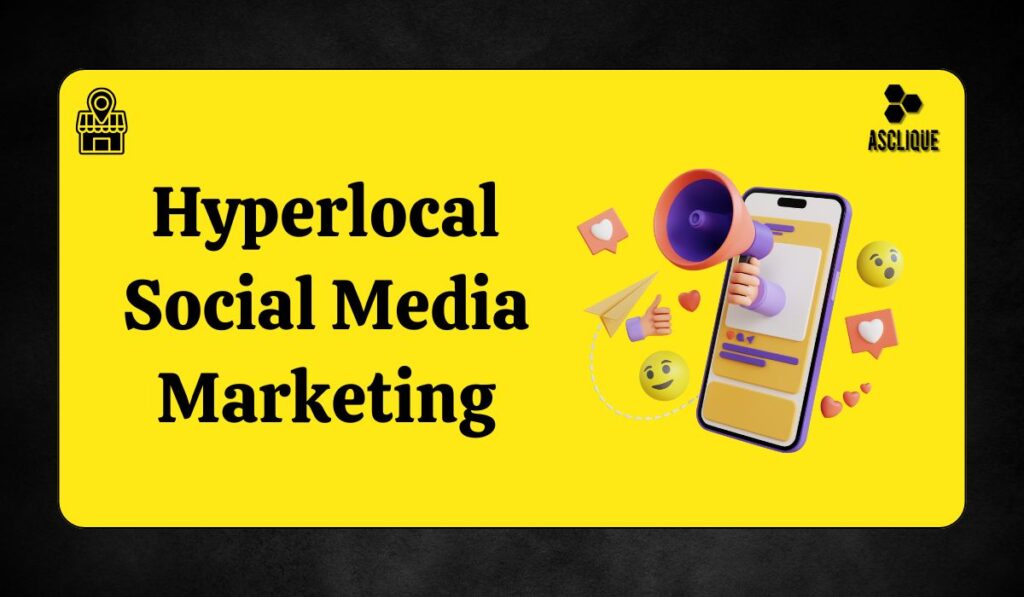A customer base in any local market can be reached using hyperlocal social media marketing in the current competitive landscape, where unparalleled importance is given to connections with the local customer. Businesses targeting their immediate community for sales and growth can make use of this method to target and engage the nearby audience.
The use of hyperlocal marketing strategy, therefore, employs social media applications as well as location-based services to target possible customers that are within the business’s geographic area. In this article, we are going to delve into what hyperlocal marketing is, why it matters, its benefits, how-to strategies, and some of the challenges that businesses may encounter.
Understanding Hyperlocal Social Media Marketing
Hyperlocal social media marketing involves the utilization of social media platforms to target a particular geographic location, often a very restricted range, such as a neighborhood or city block. Since location data and targeting options exist on platforms like Facebook, Instagram, and Google, businesses can continue to show advertisements or create posts for their local audience.
For example, a restaurant may use the promotion for locals living five miles away. Similarly, a retail shop can utilize real-time location information to reach passersby. Thus, the located areas provide specific businesses with a focus on better connection with their communities and are helpful in driving foot traffic and increasing engagement.
Key Features of Hyperlocal Marketing
- Geotargeting: Allowing businesses to target users according to their present location.
- Personalized Content: Share content that speaks right to the local audience.
- Localized Hashtags and Trends: Using local events and hashtags, even cultural nuances, for a more efficient flow of content and engagement.
How to Implement a Hyperlocal Social Media Marketing Strategy
- Use Geotargeted Ads: Facebook and Instagram are two platforms that provide advanced location targeting. Advertisers can target customers who live a given distance or even go to specified spots from their store. A restaurant, for instance, can show people living within five miles or target ads for those attending the local event nearby.
- Create Location-Specific Content: Adapt the content to the events taking place in your neighborhood. Use a local event or festival to create posts that attach your business to the relevant occasion. Update people on neighborhood news, local promotions, and any other activity happening in the area. Perhaps it could be through sharing behind-the-scenes material about your company’s participation in the community cleanup event or making promotional offers to people who joined the initiative.
- Leverage Local Influencers: Partner with local influencers and link to your business so that you enhance your outreach within the community. Influencers who have followers within your target region can help in the authenticity of their recommendations. This can help drive online and offline traffic to your business.
- Encourage User-Generated Content: Reward people to talk about your business on social media with incentives such as discounts or shout-outs. If a customer gives good review about your business, it gives community some credibility and encourages other locals to check you out.
- Optimize for “Near Me” Searches: An active Google My Business profile keeps your business optimized for “near me” search terms. You must keep your business hours, address, telephone number, and customer reviews updated to increase your rankings.
Why Are Hyperlocal Marketing Strategies Important?
Hyperlocal social media marketing is of extreme importance. Here is why:
- Focus on Local Customers: A lot of small and medium enterprises are based on local community sales. Consequently, a store or a service facility is likely to be visited by people within their vicinity. Moreover, according to studies, 46% of all Google searches have local intent, which simply means that consumers are actively searching for businesses and services near them.
- Mobile-Driven Search Growth: There is a growth in the use of mobile devices to make local searches. For instance, according to Google, “near me” form searches have increased by more than 500% in the previous few years. In this context, this means there is a clear trend in the user selecting solutions nearby. Hyperlocal marketing ensures that your business is noticed when these searches occur.
- Builds a Loyal Customer Base: People will care more about a business if it is part of their local community. Hyperlocal strategies can support businesses in developing such relationships, trust, and casual customers to faithful advocates who will return again and again.
- Drives In-Person Visits: Hyperlocal marketing is important for restaurants, gyms, or any retail shop because it generates more foot traffic. For example, the promotion of discounts or an event in a certain location might make people show up to that physical address.
The Benefits of Hyperlocal Social Media Tactics
- Increased Local Awareness: Hyperlocal strategies give a feel to businesses to get more recognition and awareness in their specific area. In such a case, there will be a higher possibility that locals will identify and opt for your business above its competitors. Such would mean that a local gym promoting a free one-week trial to everybody living within a one-mile radius is more likely to attract customers than if they ran a generic campaign for everybody.
- Cost-Effective Advertising: Because hyperlocal marketing is addressing a much smaller, targeted audience, the effort is usually much cheaper to do as well. Your money won’t be going towards campaigns that target people who have no intention of stepping foot in your place of business; instead, with a hyperlocal strategy, marketing dollars are spent on your closest geographic prospects.
- Stronger Community Connections: Engaging with the local audience by posting about local events, celebrating community wins, or sharing neighborhood news will, therefore, facilitate stronger connections with the people they serve. As such, it creates loyalty and trust, which are essentially success ingredients for businesses.
- Real-Time Targeting: Companies could use such real-time location data through Facebook and Google to target users. Deals can then be amended in real time according to the immediate locale of people. For instance, a shop could remind people around it of a lunch discount from 11 a.m. to 1 p.m. to maximize foot traffic in the slow hours.
Overcoming Challenges in Hyperlocal Marketing
- High Competition: Businesses in a crowded area will be competing with many other businesses for the same regional audience. Use unique, interesting, and relevant content that differs from competition and shows off what your business is good at.
- Limited Reach: A restricted audience is the foundation of a hyperlocal campaign. Of course, this can be concerning, but it also has some advantages. In general, even though you may have a lesser reach overall, it targets people who are probably in your area and would likely come to your business.
- Constantly Evolving Platforms: Social media platforms are constantly changing their algorithm, along with features. The study of such new features and algorithms is required to make sure the marketing strategies are on the right track.
The Future of Hyperlocal Social Media Strategies
Evolving technology will be the driving force for future hyperlocal marketing. More and more mobile and other location-based activities are going to give businesses the opportunity to interface with the locals in real-time. For example, through AR and VR, future campaigns might use unorthodox ways to connect with the local market.
But as comfort and proximity to customers remain top priorities, hyperlocal strategies will prove a vital weapon both for engaging customers online and for sending them inside.
Conclusion
Most businesses are vying for attention in the digital world, and hyperlocal social media marketing will distinguish a business by targeting customers close to your location. Therefore, with advantages like increased exposure through more cost-effective advertisements and stronger ties to the community, hyperlocal strategies have to be undertaken by businesses seeking to grow locally. Leveraging effective engagement in content, geotargeted ads, and building community, businesses can overcome barriers and really drive local business growth.
FAQ’s
How is hyperlocal marketing different from regular social media marketing?
Hyperlocal marketing will target the users within the specific localized geographic area. Regular social media marketing, on the other hand, will reach a much broader and more general audience.
Can hyperlocal marketing work for online businesses?
Online businesses, especially if the services or events they are offering are location-specific, can pin the target promotions to a specific region.
How do I measure hyperlocal marketing success?
Track engagement metrics, such as likes and shares, alongside real-world results such as increases in foot traffic, sales, and positive customer feedback.
What’s the best platform for hyperlocal marketing?
Facebook and Google My Business are top platforms that allow for geotargeting. However, according to the target audience, Instagram and Twitter would prove useful.

